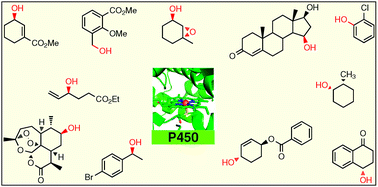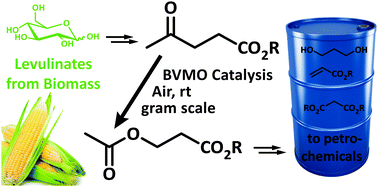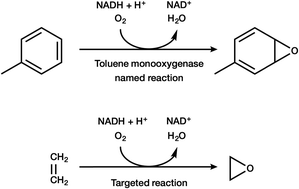Themed collection Directed Evolution

Directed evolution 2.0: improving and deciphering enzyme properties
A KnowVolution: knowledge gaining directed evolution including four phases is proposed in this feature article, which generates improved enzyme variants and molecular understanding.

Chem. Commun., 2015,51, 9760-9772
https://doi.org/10.1039/C5CC01594D
Cascade catalysis – strategies and challenges en route to preparative synthetic biology
In this feature article recent progress and future perspectives of cascade catalysis combining bio/bio or bio/chemo catalysts are presented.

Chem. Commun., 2015,51, 5798-5811
https://doi.org/10.1039/C4CC08752F
Expanding the toolbox of organic chemists: directed evolution of P450 monooxygenases as catalysts in regio- and stereoselective oxidative hydroxylation
Cytochrome P450 enzymes (CYPs) have been used for more than six decades as catalysts for the CH-activating oxidative hydroxylation of organic compounds with formation of added-value products.

Chem. Commun., 2015,51, 2208-2224
https://doi.org/10.1039/C4CC09218J
Rationally engineered variants of S-adenosylmethionine (SAM) synthase: reduced product inhibition and synthesis of artificial cofactor homologues
Rational redesign of bacterial S-adenosylmethionine-synthase by 3D-modelling and docking led to variants that allow synthesis of methylation cofactor SAM (AdoMet) without product inhibition, and of higher alkyl homologues.

Chem. Commun., 2015,51, 3637-3640
https://doi.org/10.1039/C4CC08478K
Non-hazardous Baeyer–Villiger oxidation of levulinic acid derivatives: alternative renewable access to 3-hydroxypropionates
Baeyer–Villiger monooxygenases catalyze the energetically challenging oxidation of levulinates (4-oxopentanoates) to 3-hydroxypropionic acid (3-HPA) derivates under ambient conditions, replacing propellant-grade H2O2 with aerial oxygen as the oxidant.

Chem. Commun., 2015,51, 2874-2877
https://doi.org/10.1039/C4CC08734H
A synthetic biology approach for the transformation of L-α-amino acids to the corresponding enantiopure (R)- or (S)-α-hydroxy acids
A synthetic biology approach enabled the design of a single E. coli cell catalyst co-expressing three enzymes (L-AAD, L- or D-HIC and FDH) for the quantitatively transformation of L-amino acids to the corresponding optically pure (R)- and (S)-α-hydroxy acids.

Chem. Commun., 2015,51, 2828-2831
https://doi.org/10.1039/C4CC08286A
Biocatalytic conversion of ethylene to ethylene oxide using an engineered toluene monooxygenase
We report the first recombinant enzyme in E. coli capable of transforming ethylene to ethylene oxide.

Chem. Commun., 2015,51, 2283-2285
https://doi.org/10.1039/C4CC08802F
Compact multi-enzyme pathways in P. pastoris
2A peptides enabling the coordinate expression of nine genes in P. pastoris represent a valuable tool for pathway construction and engineering.

Chem. Commun., 2015,51, 1643-1646
https://doi.org/10.1039/C4CC08502G
Myoglobin-catalyzed intermolecular carbene N–H insertion with arylamine substrates
Engineered variants of sperm whale myoglobin efficiently catalyze the insertion of α-diazo esters into the N–H bond of arylamines, featuring a combination of high chemoselectivity, elevated turnover numbers, and broad substrate scope.

Chem. Commun., 2015,51, 1532-1534
https://doi.org/10.1039/C4CC08753D
Saturation mutagenesis in selected amino acids to shift Pseudomonas sp. acidic lipase Lip I.3 substrate specificity and activity
Several Pseudomonas sp. CR611 Lip I.3 mutants with overall increased activity and a shift towards longer chain substrates were constructed.

Chem. Commun., 2015,51, 1330-1333
https://doi.org/10.1039/C4CC08477B
Evolving P450pyr monooxygenase for highly regioselective terminal hydroxylation of n-butanol to 1,4-butanediol
Directed evolution of a P450pyr created I83M/I82T mutant as the first catalyst for highly regioselective terminal hydroxylation of n-butanol to 1,4-butanediol.

Chem. Commun., 2015,51, 914-917
https://doi.org/10.1039/C4CC08479A
A thermostable transketolase evolved for aliphatic aldehyde acceptors
Directed evolution of a thermostable transketolase yields catalysts with significant improvement in activity, enantioselectivity and substrate scope.

Chem. Commun., 2015,51, 480-483
https://doi.org/10.1039/C4CC08436E
RApid Parallel Protein EvaluatoR (RAPPER), from gene to enzyme function in one day
Cell-free transcription–translation systems offer an effective and versatile platform to explore the impact of genetic variations on protein function.

Chem. Commun., 2015,51, 122-124
https://doi.org/10.1039/C4CC08240K
About this collection
Guest edited by Nicholas Turner and Frances Arnold, this web collection celebrates the current achievements and future perspectives in the excited field of directed evolution